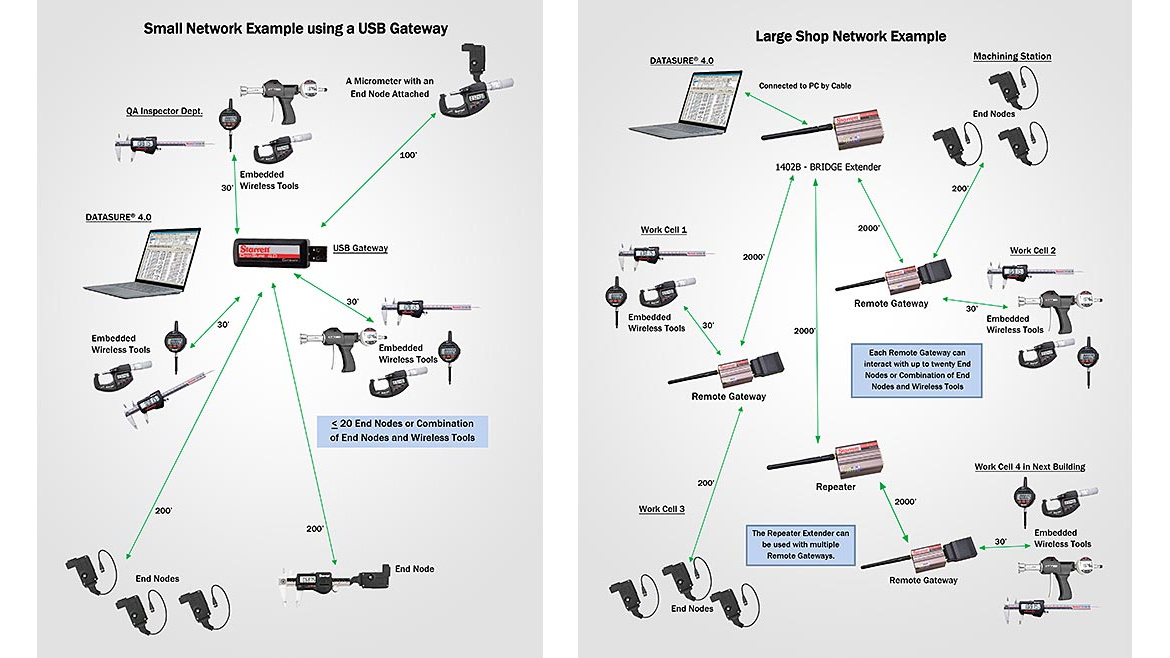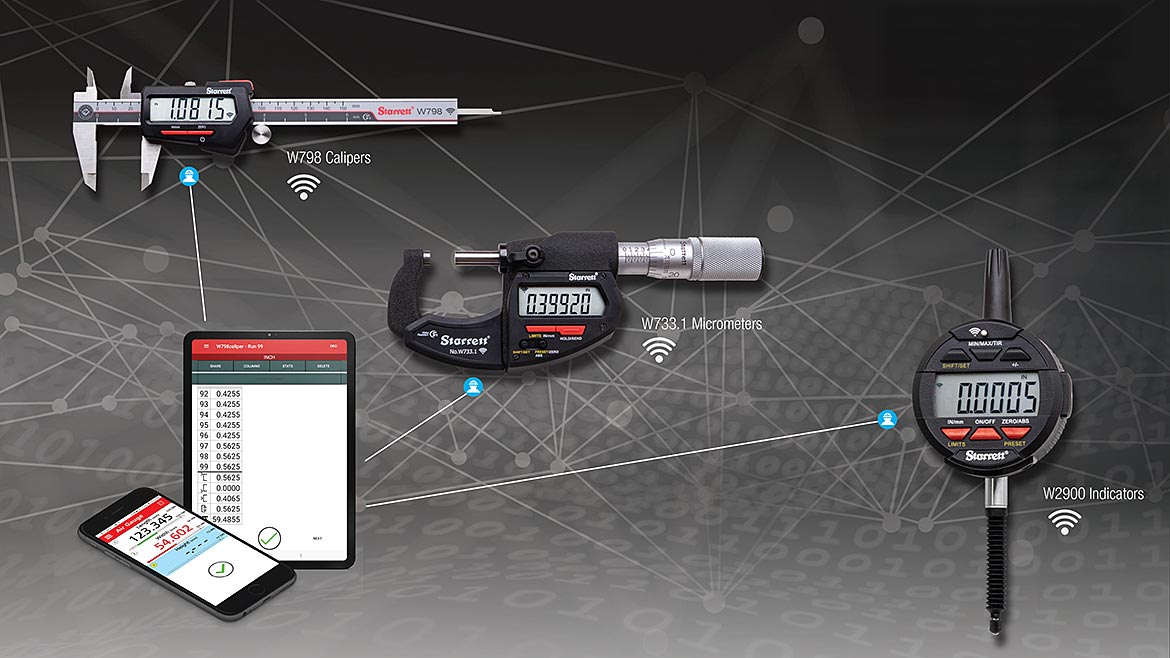You have done your homework and seen that there are many benefits to automatically collecting precision measurement data. A wireless measurement data collection system has significant advantages such as ensuring that the transfer of data from wireless and electronic measuring tools to mobile devices, tablets and computers is fast and worry-free at only a push of a button, eliminating errors that may be caused by manual transcription. Measurements taken at remote work areas are easily logged or conveyed to a third party SPC, ERP or MRP software package, and the wireless network environment allows employees to move freely without the constraints of data cables or the recording of data by hand.
Foundational benefits of today’s wireless measurement systems include automation, ease of operation, streamlined scalability, robust data encryption and protection, unrestricted distances and unencumbered use for transmission. Operating on the latest wireless networking technology that uses short-wave radio frequencies to interconnect cell phones, computers and wireless electronic devices, enables much faster speed, greater bandwidth and longer range for higher data throughput. The result is increased productivity, reduced errors, provision of full documentation and a reliable, automated data acquisition process.
Now it’s time to plan how to implement the system. Certainly, guidance from your supplier will streamline implementation and if you are wondering how to start, this primer provides a short overview.

1. Usage – Who, Where And How?
Determine who will be using the wireless data collection system and where they will be located in your facility. Will all the collection take place in one location or building, or will it be spread out over a campus or even further?
The latest data collection systems are designed to acquire precision measurement data dependably and accurately in an extensive range of applications and distances. From just one or a few measuring tools over short distances, to configurations that have many measurement tools located hundreds of yards apart in a large factory or spread out over a mile in multiple facilities, expanded distances and increased application requirements are easily accommodated as measurement data collection requirements evolve.
- A “Portable Scheme” features a wireless app running on a mobile device. This straightforward setup can have one wireless measuring tool with an embedded radio transmitting data up to 30 feet (10 meters) to a mobile device. Or, dependent on the mobile device, a Portable Scheme may have 5-8 measuring tools that connect to the mobile app for data transmission up to 30 feet (10 meters). Also, users can easily transmit measurement data up to 30 feet (10 meters) from one (or more) wireless measuring tool(s) to a laptop or PC that has a USB gateway.
- In a “Typical Scheme,” the manufacturer could have a computer or laptop running the measuring data collection system to support 20 measuring tools in the data collection process over a distance of up to 200 feet. In this setup, one USB gateway is included and backpack end nodes on the measuring tools increase the transmission range from 30 feet to 200 feet.
- In a “Large Factory Scheme” example, 20 measuring tools can use a bridge and remote gateway to expand the total data transmission range to hundreds of feet or yards.
- In an “Enterprise Scheme,” measurement data transmission can be increased from hundreds of yards to over a mile. By using remote gateways, bridges and perhaps adding in repeaters, over 100 measuring tools can be incorporated. Each remote gateway can facilitate 20 measuring tools. For even greater distances, Yagi Long Range Antennas can be incorporated in the scheme.
2. How To Resolve EMI
Since a wireless collection system relies on Radio Frequency (RF) waves, then a good RF environment must be maintained. Within a shop floor environment, there are frequent examples of noise and electromagnetic interference (EMI) sources that can disturb or otherwise impair the reliable functioning of electronics and wireless communication.
A robust wireless data collection network is designed to be less susceptible to the influence of EMI. One of the available techniques to offset EMI is to strengthen the signal with a stronger radio. By combining the data collection system with a stronger radio many of the EMI problems are overcome by increased signal strength. By using extenders within this network, you can increase the strength of the signal that in turn increases the range. The extra range may enable you to bypass noisy areas.

3. Review Capabilities Of Precision Tools & Gages
After determining that the data collection system can connect to your tools and gages (new systems have been developed to work with leading tools on the market), it is extremely productive to use wireless measuring tools that include embedded radios, making them easier to use for data collection. However, by attaching a backpack radio for expanded functionality, tools without an embedded radio can be adapted for wireless data collection.
4. Determine Where Measurements Will Be Initiated
Determine if the operator will be initiating measurements from the gage or if measurements will be initiated via computer software.
An end node “radio”, which links the output of a gage to the wireless network, connects with a gage’s data port in the same way that conventional wired cables do. The operator simply uses the data send button on the end node to send tool data. When not in use, turn the end node off to conserve battery life and prolong the time before recharging.
Alternatively, measurements can be initiated on the PC side of things by instructing the PC to send a signal to the precision gage, requesting the measurement. For example, it may be useful for supervisors or QC labs to gather the measurements from a computer to check that the operator is making parts to tolerance. This can be done manually as a one-time request, or can be automated by setting up polling to automatically request measurements.
5. System Composition - Getting In The Know
Before jumping into the user manual which will walk you through the proper installation by providing step-by-step installation instructions, it may be helpful to become familiar with some key concepts:
- Media Access Control (MAC) addresses the USB Gateway, Remote Gateways, and End Nodes which are uniquely identified by a read-only MAC address set at the time of manufacture of the radio. This set of numbers and letters helps to control various components of a network.
- The USB Gateway is a radio device that provides a point of entry for the wireless network to interface with the wireless data collection system on a PC (Server), and only one USB Gateway per PC can be used at a time.
- The Remote Gateway is a Gateway that is paired with a Bridge Extender and attached to the server PC; however, they are considered one unit. The Remote Gateway provides (at a distance) a point of entry for the wireless network to interface with the wireless data collection software. One Bridge Extender can be used with multiple Remote Gateways in a network.
- Repeat Extenders are radio devices, which provide increased signal strength, range, and scalability to the wireless network. They serve as an intermediary step between the server PC Bridge Extender and a Remote Gateway. A Repeater can communicate with more than one Remote Gateway.
- The wireless data collection system Remote Client gives you the ability to view data remotely. Data captured on the server computer may be viewed by other computers connected to a Network (LAN).
- End nodes, wireless tools, and gateways communicate securely within the network by using encryption and Security Keys. The first time an end node talks to a gateway, they establish a set of security keys. Both sides remember the key and use it to reestablish communications if needed.
- A Tool Detail webpage allows for the management and monitoring of individual devices.
- A Multiplexers webpage combines data streams of many tools, and connects them via a COM port for easy connection to software programs such as SPC.
- Sequencing is used to acquire data automatically from more than one tool over time.
- Polling is for repeatedly requesting measurement data automatically from one tool or multiplexer over time
- A Network webpage provides an overview of the network keeping track of the following network nodes, Gateways, Devices, and external connections called Remote Clients.
- An Administration webpage provides access to settings and information pertinent to network administration and management of data logs.
6. Starting Up The Wireless Data Collection System On Windows
Simple installation instructions will enable you to install the software on your PC and server, as well as activate it on your network. A Homepage serves as a quick overall view of the wireless network. This page is focused on displaying the radio devices, the information for each tool, and their gateway associations. A Gateway page shows the wireless network radios/ devices that are currently interacting with the selected Gateway.
7. Tips For Best Performance
To maximize battery life, it is recommended to only charge the battery in end nodes and wireless tools when the low battery indicator is observed. Battery condition and voltage value can be monitored in the software program.
Since metal structures can shield and block radio waves, if encountered, the radio reception/ broadcast range might diminish significantly. For example, when remote gateways and extenders are mounted on structural/vertical, ‘I’ beams or metal wall panels, radio waves are shielded or blocked behind the mounting plane of the units. Be aware that if coverage of 360 degrees around the remote gateway is needed, the metal obstruction will limit the radiation of the radio. To overcome this challenge, place remote gateways up high above machinery and their enclosures, but no more than 15 – 20 feet off the floor in an area in which measurements are to be taken.
8. Partner With A Reliable Supplier
Suppler knowledge, service and support is key when choosing a measuring wireless data collection system. A deep level of experience combined with expertise in quality control will go far in establishing a successful implementation.
